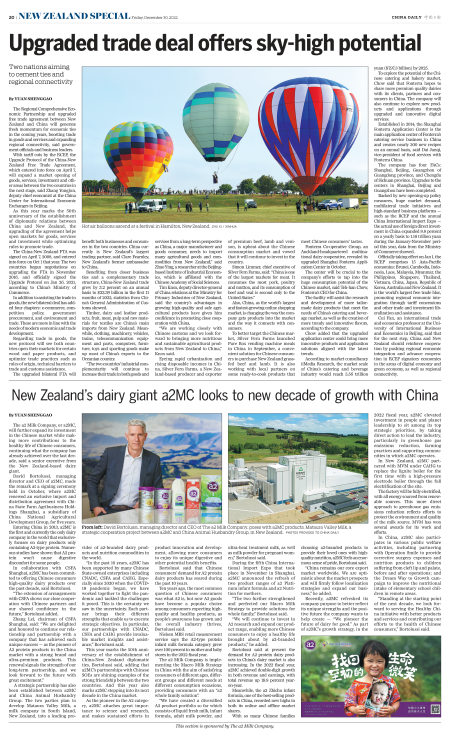
Hot air balloons ascend at a festival in Hamilton, New Zealand.
The Regional Comprehensive Economic Partnership and upgraded free trade agreement between New Zealand and China will generate fresh momentum for economic ties in the coming years, boosting trade in goods and services and expanding regional connectivity, said government officials and business leaders.
With tariff cuts by the RCEP, the Upgrade Protocol of the China-New Zealand Free Trade Agreement, which entered into force on April 7, will expand a market opening of goods, services, investment and other areas between the two countries in the next stage, said Zhang Yongjun, deputy chief economist at the China Center for International Economic Exchanges in Beijing.
As this year marks the 50th anniversary of the establishment of diplomatic relations between China and New Zealand, the upgrading of the agreement helps open markets for goods, services and investment while optimizing rules to promote trade.
The China-New Zealand FTA was signed on April 7, 2008, and entered into force on Oct 1 that year. The two countries began negotiations on upgrading the FTA in November 2016, and officially signed the Upgrade Protocol on Jan 26, 2021, according to China's Ministry of Commerce.
In addition to assisting the trade in goods, the new bilateral deal has added four chapters: e-commerce, competition policy, government procurement, and environment and trade. These are more in line with the needs of modern economic and trade development.
Regarding trade in goods, the new protocol will see both countries open their markets for certain wood and paper products, and optimize trade practices such as rules of origin, technical barriers to trade and customs assistance.
The upgraded bilateral FTA will benefit both businesses and consumers in the two countries. China currently is New Zealand's largest trading partner, said Clare Fearnley, New Zealand's former ambassador to China.
Benefiting from closer business ties and a complementary trade structure, China-New Zealand trade grew by 3.2 percent on an annual basis to $23.39 billion in the first 11 months of 2022, statistics from China's General Administration of Customs showed.
Timber, dairy and leather products, fruit, meat, pulp and raw materials for textiles are China's main imports from New Zealand. Meanwhile, clothing, machinery, vehicles, trains, telecommunication equipment and parts, computers, furniture, toys and sporting goods make up most of China's exports to the Oceanian country.
"The two countries' industrial complementarity will continue to increase their trade in both goods and services from a long-term perspective as China, a major manufacturer and goods consumer, needs to import many agricultural goods and commodities from New Zealand," said Zhao Ying, a researcher at the Beijing-based Institute of Industrial Economics, which is affiliated with the Chinese Academy of Social Sciences.
Tim Knox, deputy director-general of China relations at the Ministry for Primary Industries of New Zealand, said the country's advantages in growing high-quality and safe agricultural products have given him confidence in promoting close cooperation with China.
"We are working closely with Chinese customs and we look forward to bringing more nutritious and sustainable agricultural products from New Zealand to China," Knox said.
Eyeing rapid urbanization and rising disposable incomes in China, Silver Fern Farms, a New Zealand-based producer and exporter of premium beef, lamb and venison, is upbeat about the Chinese consumption market and vowed that it will continue to invest in the country.
Simon Limmer, chief executive of Silver Fern Farms, said: "China is one of the largest markets for meat. It consumes the most pork, poultry and mutton, and its consumption of beef and veal is second only to the United States."
Also, China, as the world's largest and fastest-growing online shopping market, is changing the way the company gets products into the market and the way it connects with consumers.
To better target the Chinese market, Silver Fern Farms launched Pure Box vending machine meals in China in September, a convenient solution for Chinese consumers to purchase New Zealand grass-fed beef and lamb. It is also working with local partners on some ready-to-cook products that meet Chinese consumers' tastes.
Fonterra Co-operative Group, an Auckland-headquartered multinational dairy cooperative, revealed its upgraded Shanghai Fonterra Application Center in October.
The center will be crucial to the company's efforts to tap into the huge consumption potential of the Chinese market, said Teh-han Chow, Fonterra's CEO for China.
The facility will assist the research and development of more tailor-made dairy products that meet the needs of China's catering and beverage market, as well as the creation of more trendy and innovative flavors, according to the company.
Chow added that the upgraded application center could bring more innovative products and application solutions aligned with the latest trends.
According to market consultancy iiMedia Research, the market scale of China's catering and beverage industry would reach 5.56 trillion yuan ($797.3 billion) by 2025.
To explore the potential of the Chinese catering and bakery market, Chow said that Fonterra hopes to share more premium quality dairies with its clients, partners and consumers in China. The company will also continue to explore new products and applications through upgraded and innovative digital services.
Established in 2014, the Shanghai Fonterra Application Center is the main application center of Fonterra's catering service business in China and creates nearly 300 new recipes on an annual basis, said Dai Junqi, vice-president of food services with Fonterra China.
The company has four FACs: Shanghai, Beijing, Guangzhou of Guangdong province, and Chengdu of Sichuan province. Upgrades to the centers in Shanghai, Beijing and Guangzhou have been completed.
Backed by new opening-up policy measures, huge market demand, multilateral trade initiatives and high-standard business platforms — such as the RCEP and the annual China International Import Expo — the actual use of foreign direct investment in China expanded 9.9 percent on a yearly basis to 1.16 trillion yuan during the January-November period this year, data from the Ministry of Commerce showed.
Officially taking effect on Jan 1, the RCEP comprises 15 Asia-Pacific economies: Brunei, Cambodia, Indonesia, Laos, Malaysia, Myanmar, the Philippines, Singapore, Thailand, Vietnam, China, Japan, Republic of Korea, Australia and New Zealand. It is the world's largest free trade bloc, promoting regional economic integration through tariff concessions and other trade and investment liberalization and assistance.
Cui Fan, an international trade and economics professor at the University of International Business and Economics in Beijing, said that for the next step, China and New Zealand should reinforce cooperation by pushing regional economic integration and advance cooperation in RCEP signatory economies in the areas of digital economy and green economy, as well as regional connectivity.

